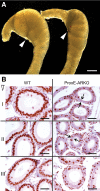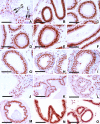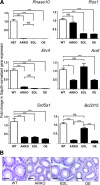Targeted inactivation of the androgen receptor gene in murine proximal epididymis causes epithelial hypotrophy and obstructive azoospermia
- PMID: 21084446
- PMCID: PMC3101806
- DOI: 10.1210/en.2010-0768
Targeted inactivation of the androgen receptor gene in murine proximal epididymis causes epithelial hypotrophy and obstructive azoospermia
Abstract
The epithelial lining of the epididymal duct expresses the androgen receptor (Ar) along its entire length and undergoes rapid and profound degeneration when androgenic support is withdrawn. However, experiments involving orchidectomy with systemic testosterone replacement, and testicular efferent duct ligation, have indicated that structural and functional integrity of the initial segment cannot be maintained by circulating androgen alone, leaving the role of androgen in this epididymal zone unclear. We addressed this question in a mouse model with intact testicular output and selective Ar inactivation in the proximal epididymis by creating double-transgenic males carrying a conditional Ar(loxP) allele and expressing Cre recombinase under the promoter of Rnase10, a gene specifically expressed in proximal epididymis. At 20-25 d of life, on the onset of Rnase10 expression, Ar became selectively inactivated in the principal cells of proximal epididymis, resulting in epithelial hypoplasia and hypotrophy. Upon the subsequent onset of spermiation, epididymal obstruction ensued, with the consequent development of spermatic granulomata, back pressure-induced atrophy of the seminiferous epithelium, orchitis, and fibrosis of the testicular parenchyma. Consistent with these findings, the mice were infertile. When the effect of Ar knockout on gene expression in the proximal epididymis was compared with that of efferent duct ligation and orchidectomy, we identified genes specifically regulated by androgen, testicular efferent fluid, and both. Our findings demonstrate that the development and function of the epididymal initial segment is critically dependent on direct androgen regulation. The phenotype of the produced knockout mouse provides a novel model for obstructive azoospermia.
Figures





Similar articles
-
Androgen receptor expression in the caput epididymal epithelium is essential for development of the initial segment and epididymal spermatozoa transit.Endocrinology. 2011 Feb;152(2):718-29. doi: 10.1210/en.2010-0928. Epub 2010 Dec 22. Endocrinology. 2011. PMID: 21177831
-
Circulating and luminal testicular factors affect LRP-2 and Apo J expression in the epididymis following efferent duct ligation.J Androl. 2000 Jan-Feb;21(1):122-44. J Androl. 2000. PMID: 10670527
-
Essential roles of androgen signaling in Wolffian duct stabilization and epididymal cell differentiation.Endocrinology. 2011 Apr;152(4):1640-51. doi: 10.1210/en.2010-1121. Epub 2011 Feb 8. Endocrinology. 2011. PMID: 21303954 Free PMC article.
-
Regulation of epididymal epithelial cell functions.Biol Reprod. 1995 Feb;52(2):226-36. doi: 10.1095/biolreprod52.2.226. Biol Reprod. 1995. PMID: 7711192 Review.
-
Androgen receptor roles in spermatogenesis and fertility: lessons from testicular cell-specific androgen receptor knockout mice.Endocr Rev. 2009 Apr;30(2):119-32. doi: 10.1210/er.2008-0025. Epub 2009 Jan 27. Endocr Rev. 2009. PMID: 19176467 Free PMC article. Review.
Cited by
-
Is the Epididymis a Series of Organs Placed Side By Side?Biol Reprod. 2016 Jul;95(1):10. doi: 10.1095/biolreprod.116.138768. Epub 2016 Apr 27. Biol Reprod. 2016. PMID: 27122633 Free PMC article. Review.
-
Sequential testicular atrophy involves changes in cellular proliferation and apoptosis associated with variations in aromatase P450 expression levels in Irs-2-deficient mice.J Anat. 2019 Feb;234(2):227-243. doi: 10.1111/joa.12917. Epub 2018 Nov 25. J Anat. 2019. PMID: 30474117 Free PMC article.
-
A novel transcriptional network for the androgen receptor in human epididymis epithelial cells.Mol Hum Reprod. 2018 Sep 1;24(9):433-443. doi: 10.1093/molehr/gay029. Mol Hum Reprod. 2018. PMID: 30016502 Free PMC article.
-
Seminal fluid metabolome and epididymal changes after antibiotic treatment in mice.Reproduction. 2018 Jul;156(1):1-10. doi: 10.1530/REP-18-0072. Epub 2018 Apr 24. Reproduction. 2018. PMID: 29692359 Free PMC article.
-
Epithelial and mesenchymal fate decisions in Wolffian duct development.Trends Endocrinol Metab. 2023 Aug;34(8):462-473. doi: 10.1016/j.tem.2023.05.007. Epub 2023 Jun 15. Trends Endocrinol Metab. 2023. PMID: 37330364 Free PMC article. Review.
References
-
- Robaire B, Hinton BT, Orgebin-Crist MC. 2006. The epididymis. In: Neill JD. ed. Knobil and Neilly's physiology of reproduction. Vol 1 San Diego: Elsevier Academic Press; 1071–1148
-
- Fawcett DW, Hoffer AP. 1979. Failure of exogenous androgen to prevent regression of the initial segments of the rat epididymis after efferent duct ligation or orchidectomy. Biol Reprod 20:162–181 - PubMed
-
- Hamzeh M, Robaire B. 2009. Effect of testosterone on epithelial cell proliferation in the regressed rat epididymis. J Androl 30:200–212 - PubMed
-
- Zhou Q, Nie R, Prins GS, Saunders PT, Katzenellenbogen BS, Hess RA. 2002. Localization of androgen and estrogen receptors in adult male mouse reproductive tract. J Androl 23:870–881 - PubMed
-
- De Gendt K, Swinnen JV, Saunders PT, Schoonjans L, Dewerchin M, Devos A, Tan K, Atanassova N, Claessens F, Lécureuil C, Heyns W, Carmeliet P, Guillou F, Sharpe RM, Verhoeven G. 2004. A Sertoli cell-selective knockout of the androgen receptor causes spermatogenic arrest in meiosis. Proc Natl Acad Sci USA 101:1327–1332 - PMC - PubMed
Publication types
MeSH terms
Substances
Grants and funding
LinkOut - more resources
Full Text Sources
Molecular Biology Databases
Research Materials

